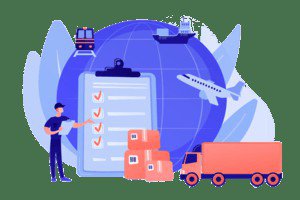
Global transportation and shipping are the lifeblood of the world economy. As focus on e-commerce and global shipping continues to grow, the value of products moving through customs continues to rise as well. According to the United States Census Bureau, the average value of imports coming into the country increased by $4 billion over July levels, reaching a total of $287 billion. Meanwhile, August exports were $213.7 billion, $1 billion more than July exports. There’s a balance between the two and trends like these occur in every primary industry. This is bringing the need for improved customs clearance and shipping monitoring to the forefront of transportation management. To help shippers maintain control over imports and reduce confusion or delays in customs, this blog will explore:
- The basics of customs clearance.
- Customs clearance timelines and costs.
- Five importing best practices for reducing costs and speeding ocean freight execution.
Basics of Customs Clearance?
Customs refers to a set of special services and checks that must occur before goods can be imported or exported, and customs clearance is mandatory for every shipment that crosses an international border. If the freight clears and documentation is approved, that confirms inspections and all necessary protocols have been completed satisfactorily. Specific information regarding the shipment’s content, point of origin, destination, value, and other critical data points must be exchanged during this process, which also involves:
- Paperwork Verification. A customs officer will ask for all required documents to verify that the cargo can safely move across the border. Once the shipping documents, including the BOL and manifest, is confirmed, the shipper is allowed to continue with the import or export.
- Payments, Taxes, Duties. Any taxes, fees, and charges that are legally required will need to be paid. Delays in payment will inevitably amount to delays in clearance.
- Release of Shipment. Once all fees, duties and other payments have been finalized, then the shipment is cleared and the goods head to the destination.
When Is Customs Clearance Needed?
Shipment customs clearance and general import custom clearance processes remain necessary for all packages entering the U.S. from other countries. The U.S. Customs and Border Protection (CBP), the agency that is responsible for enforcing U.S. import laws and regulations, provides a form for transportation service providers to complete before they can cross the border. CBP also requires an official description of the cargo, often referred to as a declaration statement or explanation.
How Long Does It Take for Customs Clearance to Complete?
In most cases, the import customs clearance process takes less than 24 hours for simple and essential cargo, such as foods or commodities. However, instances can occur where it takes several days or weeks for goods to be inspected, though these occur with higher value, hazardous, or specialty loads, such as moving lithium-ion batteries or pharmaceuticals. Proper planning is critical for navigating import custom clearance processes and achieving import customs clearance success.
How Much Does It Cost?
Each customs checkpoint can have varying terms and charge different prices and fees in addition to ones set by local and national guidelines and laws. The specifics of each load can significantly impact the cost of clearing customs and payment of fees, duties, and other charges. The weight and dimensions of the load, the nature of the contents in the container, its destination, the country of origin, its commercial value, and a host of other factors determine the final cost for passing customs.
Top Import Practices to Speed Customs Clearance
Detailed preparation is the key to successfully navigating customs clearance. Knowing the clearance requirements, as well as your obligations and responsibilities, can help ensure a seamless experience at the border. Further, proper preparation helps avoid costly delays or charges. Understanding and following the best practices can make clearing customs faster and easier than ever before. The best practices to keep in mind for international container load shipping include the following.
Know Your Shipment Specifics
The most important thing to prepare for customs is to know what specific documentation, records, statements, and information you will have to provide to the customs agent. Planning before you arrive will make things much easier and less stressful. As highlighted by CBP, “When calling the port, the importer should be able to provide as much detail regarding the transaction as possible. For the import specialist to best assist you, it is important you be able to describe the merchandise you are planning to import exactly. In order for the import specialist to best assist you, you should provide a complete description of the article and answer specific questions such as: 1) the country of origin of the merchandise and manufacturer; 2) the composition of the merchandise; 3) the intended use of the item; and 4) pricing/payment information (in order to properly determine the value of the shipment).”
Have Customs Clearance Documents Ready to Roll
It is essential to double-check that everything is together and accurate. Outdated or missing documentation can cause long delays or incur fees due to penalties for failure to comply with regulations.
While many of the documents considered standard requirements for customs throughout the world are the same, most countries also require their own unique paperwork and records. Remember this fact—that international trade might require specialized documentation on all imports and exports. For instance, the United States-Mexico-Canada Agreement (USMCA) requires cross-border shipments to include a USMCA Certificate of Origin. Some countries and border customs have additional requirements as well.
Fortunately, digital documents and electronic signatures can help alleviate some of this stress while also speeding up the overall process of import customs clearance. It can also help to reduce confusion, allow for less risk in the transmission of documents, create faster lines of communication, enable pre-inspection of cargo rosters, reduce the risk of damages during the inspection, and boost throughput.
Use Technology to Automate Clearance and Reap the Benefits of Faster Processing
Customs officials will meticulously examine all documentation to ensure goods aren’t shipped illegally or that shippers don’t dodge duties and taxes on specific items and loads. When a shipper fails to describe the contents of their cargo accurately, delays will occur as a manual check and comparison will then be required to confirm the exact load contents. Additionally, fines and potential legal issues stem from falsifying documents or failing to make complete and accurate disclosures. Even inadvertent minor errors and omissions will have repercussions.
When preparing your documents for an international shipment, don’t be vague. Don’t use general, relative terms and figures. And whenever possible, it is always in your best interest to use technology to streamline the process. For instance, consider these ways electronic records can benefit the clearinghouse process:
- Reduced compliance costs and fewer instances of compliance fees.
- Decreased risk of inspection and import custom clearance processes.
- Optimized processes with automated recording and filing of papers.
- Less time-to-release and faster inspection times at borders.
- Duty minimization with instant checks and automated document scans.
- Free trade agreement advisory services and advanced amenities.
- Automated notification for shipment status changes and updates.
Use the Correct Incoterms
The International Chamber of Commerce (ICC) is the body that oversees many of the laws and regulations that help govern customs and cross-border importing and exporting. They publish and update the Incoterm rules every 10 years based on the state of global trade and updated policies. Incoterms for import customs clearance currently include:
- Ex Works (EXW)
- Free Carrier (FCA)
- Carriage Paid To (CPT)
- Carriage and Insurance Paid To (CIP)
- Delivered at Place (DAP)
- Delivered at Place Unloaded (DPU)
- Delivered Duty Paid (DDP)
- Free Alongside Ship (FAS)
- Free on Board (FOB)
- Cost and Freight (CFR)
- Cost, Insurance and Freight (CIF)
For transportation service providers working within international trade, understanding these terms means knowing where buyer-seller obligations end and begin. They are also critical to knowing how freight costs evolve, the current requirements for your team, shipment customs clearance protocols, and the options best suited for specific types of cargo.
Leverage a Digital Freight Marketplace to Balance Shipping Schedules With Customs Clearance
Utilizing the innovative power of digital freight marketplaces—in other words, matching platforms and apps—can help shippers balance the arrival of freight with customs clearance. It helps organize the step-by-step process to avoid delays. Digital freight marketplaces also make it easier for teams to maintain shipping schedules and move from one leg of shipping to the next. It can help balance inspection, payments, document filing, reporting, shipping capacity, and more.
With the recent push of e-commerce amid global shopping and economic growth, the added stress on ocean transportation amounts to more stress in customs. Anything that can be done to expedite the process and make things easier for customs officials will make things easier for shippers and carriers in the long run. And finding capacity, managing freight through customs, and having a ready-to-execute plan of action will be key to boosting throughput.
Streamline Import Customs Clearance With an Ocean Shipping Digital Freight Marketplace
Customs clearance might seem like an inconvenience, but extensive security checks are conducted by border customs agents who must approve every shipment before it is unloaded and distributed. Any mistake on your part could cost thousands of dollars due to delays, which could extend indefinitely. Since obtaining shipment customs clearance can be challenging, finding any way to streamline tasks can help the entire process go smoothly. Embracing the power and innovation of a world-class ocean shipping digital freight marketplace, combined with state-of-the-art tracking and process automation, can make customs clearance simple and easy. Contact FreightMango today to get started.





 Get instant quote
and compare offers in real time
Get instant quote
and compare offers in real time